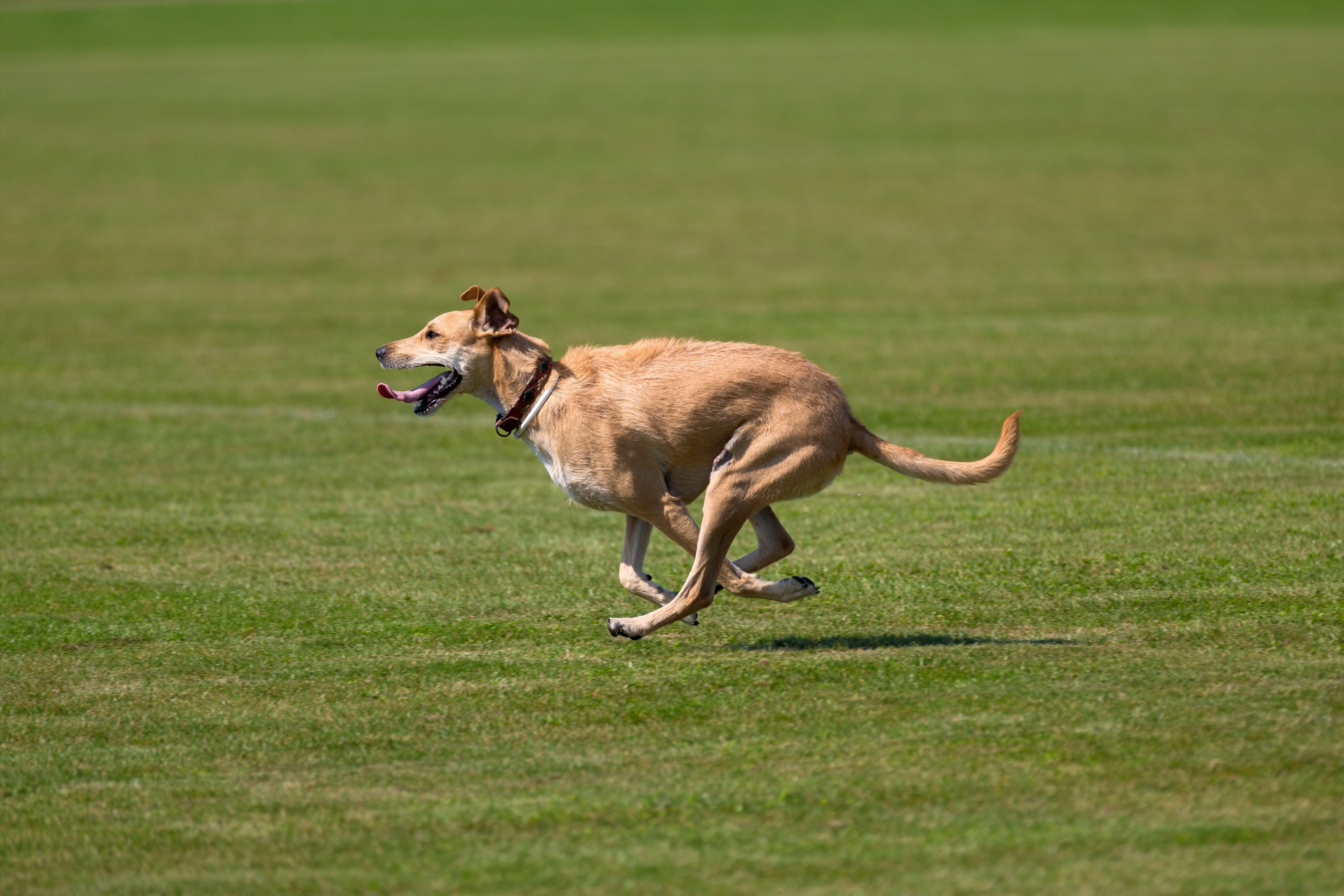Have you ever wondered why some dogs chase cats or squirrels, while others barely seem to notice them? Like any behavior, environment and experiences can influence how a dog acts, but when it comes to dogs chasing other animals, instincts play a major role.
While prey drive exists—at least to a degree—in all dogs, some dogs have a stronger prey drive than others. Let’s take a closer look at a dog’s predatory instincts and how their DNA shapes their behavior.
What is prey drive in dogs?
Prey drive in dogs is a natural desire to chase and catch moving objects, whether that’s a cat, a squirrel, or even a tennis ball. This instinct is necessary to survival for any large wild carnivore, like wolves, the ancestor to domestic dogs. Wolves are predators that rely on hunting, capturing, and killing prey in order to eat. While domesticated dogs no longer have the same need to hunt for food, the instinct to chase and catch remains. In fact, their natural ability to track and catch animals made them an ideal partner for human hunters and is one reason dogs have evolved to become such an integral part of the human world.
As people began selectively breeding dogs for specific roles—such as hunting, herding, or retrieving—they intentionally enhanced certain aspects of prey drive to suit different jobs. As a result, some breeds are more hardwired to chase or stalk, while others have more subdued prey instincts.
While prey drive is a form of predatory aggression, it’s entirely different and independent from other forms of aggression in dogs. That means a dog with a high prey drive that pursues small animals may be just fine with other dogs or people.

How breed and genetics shape dog prey drive
As mentioned, in order to perform certain jobs, some dog breeds were bred to have high energy, determination, and focus when chasing moving targets—all traits that correspond with prey instinct. Following are some of the dog breeds known for having a higher prey drive.
Hounds
Hounds like Beagles, Bloodhounds, and Coonhounds are well-known for their powerful noses and tracking abilities. These dogs are prized for their ability to track scent trails for miles. And once they find their target, their instinct to pursue kicks in.
Greyhounds and Whippets, on the other hand, were bred to chase down prey (or racing lures) with their incredible speed and explosive energy. Unlike scent hounds, these sighthounds rely more on their vision to spot their target.
Terriers
Dog breeds in the Terrier breed group, including Jack Russell Terriers, Rat Terriers, and West Highland White Terriers, were bred to hunt and eliminate small rodents, and therefore were selected specifically for high prey drive. Particularly working terrier breeds have a prey drive that can be intense and persistent, often leading them to dig, pounce, or ferret out small creatures with impressive focus.
Sporting breeds
Dogs in the Sporting group, including Labrador Retrievers, Brittanys, and German Shorthaired Pointers, were bred for a different purpose: to locate and retrieve birds during a hunt. Their prey drive is present but directed toward fetching rather than chasing down prey. This explains why so many breeds in the sporting group love playing fetch, as it taps into that natural retrieving instinct.
Asian and Oceanian breeds
Dogs in the Asian and Oceanian breed group, which includes Siberian Huskies, Chow Chows, and Malamutes, also tend to have a high prey drive. This group includes a lot more primitive breeds, and thus they have retained a stronger instinctual predatory drive.
Herding breeds
Herding dogs like Border Collies, Australian Shepherds, and Pembroke Welsh Corgis show a modified form of prey drive. Instead of completing the hunting sequence by capturing or killing, herding dogs’ instincts push them to control or gather livestock, using movement (and sometimes gentle nips) to guide animals—which to the animals being herded looks very much like a predator stalking their prey. Breeds bred to herd cattle and pigs are more likely to be particularly driven versus those that were bred to herd sheep and goats, which require a gentler herding style.
This “arrested prey drive” is a hallmark of herding breeds, allowing them to manage other animals without harming them—a perfect adaptation for their role on farms and ranches.

Dog breeds with a low prey drive
Not every dog is wired to chase. Breeds like Mastiffs, Great Pyrenees, and Bulldogs tend to have lower prey drives. These dogs were bred primarily for watching over people, livestock, or property rather than pursuing moving animals. As a result, they’re more likely to remain calm and steady when faced with small, fast-moving creatures. However, not every breed in the Guard breed group has a low prey drive, so careful research is needed when selecting a breed.
Dogs in the Companion breed group, including the Bichon Frise, Maltese, and Pug, also tend to have a lower prey drive. As their breed group name suggests, these pups are more content to hang out with their humans than chase after other animals.
While individual dogs will vary, these breeds generally don’t show the same chasing instincts as hounds, terriers, sporting, asian and oceanian, or herding dogs.

How to manage prey drive in dogs
A dog’s instincts form the foundation for prey drive, but training and environment play a big role in how that natural tendency does (or does not) show up in everyday life.
Prey drive is a very instinctual behavior, so if your dog has it, you’re not going to successfully “train it out” of your dog as you might for other behaviors—and you should plan accordingly. You can provide enrichment to meet your dog’s natural need to chase, and prepare their environment so that smaller animals always have a means of escape. This is important, because a dog chasing cats, squirrels, or other moving objects can create dangerous situations for them or cause other animals to get hurt or killed.
Sighthounds in particular are extremely fast, and an incident can occur before you have time to react. Puppies don’t necessarily show prey drive right away, whereas adolescent and adult dogs are more likely to give you a true indication of what their mature behaviors will be.
Here are a few strategies for managing a dog with a strong prey drive:
- Always use a leash when on walks. Squirrels, birds, and neighborhood cats can appear at any time and a leash prevents dangerous mishaps. Recalls are not reliable for a dog with high prey drive.
- If you are considering adopting a dog and you already have a cat, make sure the dog has had a behavioral evaluation for prey drive, and ideally, arrange a trial period where all interactions with your cat are supervised—with the new dog on leash—to monitor for any red flags. If acquiring a dog from a breeder, ask about the behaviors of the parents to give you an idea of what to expect. None of these precautions will guarantee safe interactions, but do increase the likelihood of successful coexistence.
- Use a long leash in open areas. A long-line gives your dog room to explore while maintaining control, reducing the risk of bolting after wildlife.
- Provide plenty of mental stimulation. Puzzle toys and scent games can satisfy your dog’s hunting brain without needing actual prey.
- Channel their energy to appropriate outlets. Activities like fetch, agility, lure coursing, or flyball can give your dog healthy ways to express their instincts.
- Prevent all unmonitored interaction with small prey if your dog has high prey drive. If that is not possible, make sure wildlife or cats have an escape route to get away.
How DNA testing can help you understand your dog’s behavior and instincts
Wisdom Panel’s dog DNA testing can uncover insights into your dog’s breed mix that help you understand their instincts and behaviors. By understanding your pup’s genetic background and the traits associated with their breed mix, you can tailor their training and care to meet their specific needs.
Final thoughts
A dog’s prey drive is written into their DNA. But there are actions you can take to create an environment that minimizes chasing cats and other moving objects. By recognizing and respecting their natural drives and providing the right training and outlets, you can help your dog thrive—no matter what catches their eye.














